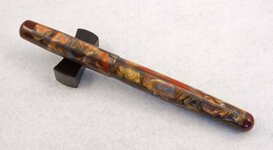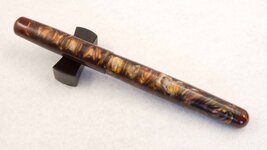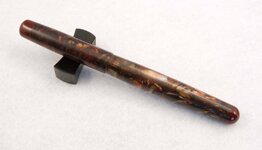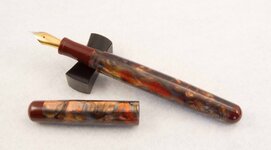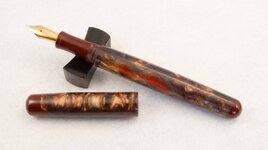Very nice work on this one! I noticed the sheen is less (or lower) on the barrels vs the end caps of different material. Is that purely by intent and design, or more the result of just being the outcome you get with Flexigran? I have tried that material, and have not been able to finish it out to a really high sheen. So I wondered if you experienced the same limitation?
I am not an expert on resins, but I will hazard a guess that the density of the material and the strength of its molecular chains, and their bonding, have an effect on how well it takes a sheen. The italian resin has relatively strong molecular chains (I think better than polyester resin or some others) but it can be brittle if you force it, e.g., try to turn too much material off in one pass or too quickly, or cut too thin a wall section and it will chip. It may not chip as easily as polyester resin, but it will chip. It takes a nice sheen, perhaps because its less strong molecular chains give up material easily and cleanly from the ends of molecular chains allowing it to be smoothed down uniformly to produce a nice sheen.
What I have experienced with the very "tough" and molecularly dense resins like FLEXIGRAN and alumilite is their much appreciated ability to be threaded with taps and dies and lack of brittleness seems to come at the expense of easily producing the desired eye popping sheen. In other words, when these materials are sanded and buffed, instead of loosing material to a uniform level of smoothness, the top layer of these tough molecular chains gets frayed, like a nylon rope that is coming apart, until we achieve what we think is a dull sheen. I also think the dyes and pigments have some bearing on the sheen produced. In my experience it is harder to produce a sheen with some colors and concentrations of color; the blue / gold flexigran has been the best-to-polish flexigran for me.
So, I tend to equate increasing brittleness with an increasing ability to take an easy, but eye catching sheen, but at the expense of machinability. Conversely, the more machinable a resin becomes the harder to achieve the same sheen even as the desirable mechanical properties improve. And cost goes up as machinability improves, generally. To be honest, I find the sheen on flexigran and alumilite more appealing because it is subdued and doesn't have that plastic look. But that is just my opinion as has been all of the above. Hope this helped and thanks for your question on something I have thought about a lot. I am still working on a surface prep protocol for flexigran and alumilite to give me the "best" finish, LOL.

